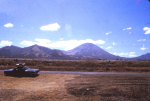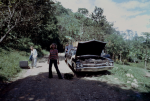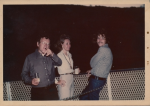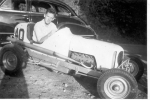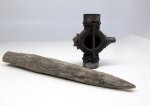JackW
Explorer
This is a report I wrote of a trip we took 49 years ago - looking back it was a lot of fun and a big adventure.
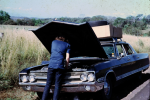
I was lucky enough to have some pretty adventurous parents who liked to travel (and drag their kids along) to some pretty neat places. They met in 1945 when my dad was going to Georgia Tech and my mom was an Atlanta native attending Agnes Scott. Dad was born in New Jersey but had lived in Sydney, Australia and grew up in the Panama Canal Zone. He graduated from Balboa High School in 1944 and joined the US Navy with the ambition to become a fighter pilot – specifically the F4-U Corsair. Luckily for me the war ended before he finished training or this story may have never happened. After finishing his masters in electrical engineering he went to work for RCA, did a year at Studebaker and then came to Lockheed Georgia in 1955 to establish their NC machine shop. My two sisters and I grew up in Atlanta and we had many occasions to travel all over the US in the family Ford Country Squire station wagons.
In 1974 Dad had a much more ambitious plan for us – his thirty year high school reunion was coming up and he wanted us to drive to Panama so we could see the Canal and where he spent 12 years of his life.
Back in 1974 the Pan-American Highway was more of a concept than an actual road in many of the countries south of the US Border. Dad’s plan was to buy a car big enough for us to drive through Central America but cheap enough to walk away from and fly home at the end of the trip (it was always planned to be a one-way drive). His choice for our adventure was a pretty unlikely steed – a big black 1965 Buick 225 Electra four door sedan with lots of chrome. The deuce and a quarter as they were called cost a princely $600 – our departure date was the second week of January.
The plan was for my dad and I to drive the first 1800 miles to Mexico City where we would pick up mom and my little sister as they flew in from Atlanta. From there the rest of the trip would cover another 2600 miles through southern Mexico, Guatemala, El Salvador, Honduras, Nicaragua, Costa Rica and Panama. We only had four days from our departure from Atlanta to get to Mexico City to meet the girls so we decided to recruit another driver to help and convinced Ken, the son of some family friends to join us.
Our trip preparations consisted of building a big wooden box to mount on some gutter mount roof racks to hold an extra spare tire and three 5 gallon cans – two for gasoline and one for water. We packed a rudimentary tool kit with some wrenches and screwdrivers, a box of some food, our clothes and considered ourselves ready to go. Notice the complete lack of any of the “required” expedition gear we are so fond of now.
We left Atlanta on Tuesday morning – with the requirement that we be at Mexico City airport by 10:00 AM Saturday to pick up Mom and Lisa. In 1974, I-85 ended at Newnan and didn’t resume until you got almost to Montgomery, Alabama. Nobody said it was going to be easy. Everything went pretty smoothly for the first couple of hundred miles…..
Somewhere in southern Mississippi the top radiator hose exploded; a small portent of what would become a recurring theme throughout the rest of the trip. As we waited on the side of the highway for the mighty Buick to cool off enough to remove the radiator cap I took the water can to the nearest house to fill it up. It was an old sharecropper’s cabin with a hand pump in the front yard. The old black man on the front porch graciously said to help myself and I filled up the can and lugged it back to the steaming Buick. We wrapped a rag and some duct tape around the hose to patch it up enough to get us to the next town where we got a new hose but the 225 never really ran right from then on. This little problem threw a bit of a wrench into our schedule and disrupted our plans to take a leisurely drive through southern Texas on our way to the border.
As we crossed through Texas via Houston and San Antonio with a quick stop to visit the Alamo on day two it was obvious that the Buick was not happy. We made it to Laredo that evening and some under hood exploration revealed that the water pump was way past its prime. The first thing to do the next morning was to find an auto parts store and buy a new water pump which I changed right there in the parking lot. By 9:00 AM we were ready to cross the border into Mexico and the adventure officially began.

I was lucky enough to have some pretty adventurous parents who liked to travel (and drag their kids along) to some pretty neat places. They met in 1945 when my dad was going to Georgia Tech and my mom was an Atlanta native attending Agnes Scott. Dad was born in New Jersey but had lived in Sydney, Australia and grew up in the Panama Canal Zone. He graduated from Balboa High School in 1944 and joined the US Navy with the ambition to become a fighter pilot – specifically the F4-U Corsair. Luckily for me the war ended before he finished training or this story may have never happened. After finishing his masters in electrical engineering he went to work for RCA, did a year at Studebaker and then came to Lockheed Georgia in 1955 to establish their NC machine shop. My two sisters and I grew up in Atlanta and we had many occasions to travel all over the US in the family Ford Country Squire station wagons.
In 1974 Dad had a much more ambitious plan for us – his thirty year high school reunion was coming up and he wanted us to drive to Panama so we could see the Canal and where he spent 12 years of his life.
Back in 1974 the Pan-American Highway was more of a concept than an actual road in many of the countries south of the US Border. Dad’s plan was to buy a car big enough for us to drive through Central America but cheap enough to walk away from and fly home at the end of the trip (it was always planned to be a one-way drive). His choice for our adventure was a pretty unlikely steed – a big black 1965 Buick 225 Electra four door sedan with lots of chrome. The deuce and a quarter as they were called cost a princely $600 – our departure date was the second week of January.
The plan was for my dad and I to drive the first 1800 miles to Mexico City where we would pick up mom and my little sister as they flew in from Atlanta. From there the rest of the trip would cover another 2600 miles through southern Mexico, Guatemala, El Salvador, Honduras, Nicaragua, Costa Rica and Panama. We only had four days from our departure from Atlanta to get to Mexico City to meet the girls so we decided to recruit another driver to help and convinced Ken, the son of some family friends to join us.
Our trip preparations consisted of building a big wooden box to mount on some gutter mount roof racks to hold an extra spare tire and three 5 gallon cans – two for gasoline and one for water. We packed a rudimentary tool kit with some wrenches and screwdrivers, a box of some food, our clothes and considered ourselves ready to go. Notice the complete lack of any of the “required” expedition gear we are so fond of now.
We left Atlanta on Tuesday morning – with the requirement that we be at Mexico City airport by 10:00 AM Saturday to pick up Mom and Lisa. In 1974, I-85 ended at Newnan and didn’t resume until you got almost to Montgomery, Alabama. Nobody said it was going to be easy. Everything went pretty smoothly for the first couple of hundred miles…..
Somewhere in southern Mississippi the top radiator hose exploded; a small portent of what would become a recurring theme throughout the rest of the trip. As we waited on the side of the highway for the mighty Buick to cool off enough to remove the radiator cap I took the water can to the nearest house to fill it up. It was an old sharecropper’s cabin with a hand pump in the front yard. The old black man on the front porch graciously said to help myself and I filled up the can and lugged it back to the steaming Buick. We wrapped a rag and some duct tape around the hose to patch it up enough to get us to the next town where we got a new hose but the 225 never really ran right from then on. This little problem threw a bit of a wrench into our schedule and disrupted our plans to take a leisurely drive through southern Texas on our way to the border.
As we crossed through Texas via Houston and San Antonio with a quick stop to visit the Alamo on day two it was obvious that the Buick was not happy. We made it to Laredo that evening and some under hood exploration revealed that the water pump was way past its prime. The first thing to do the next morning was to find an auto parts store and buy a new water pump which I changed right there in the parking lot. By 9:00 AM we were ready to cross the border into Mexico and the adventure officially began.
Last edited:



